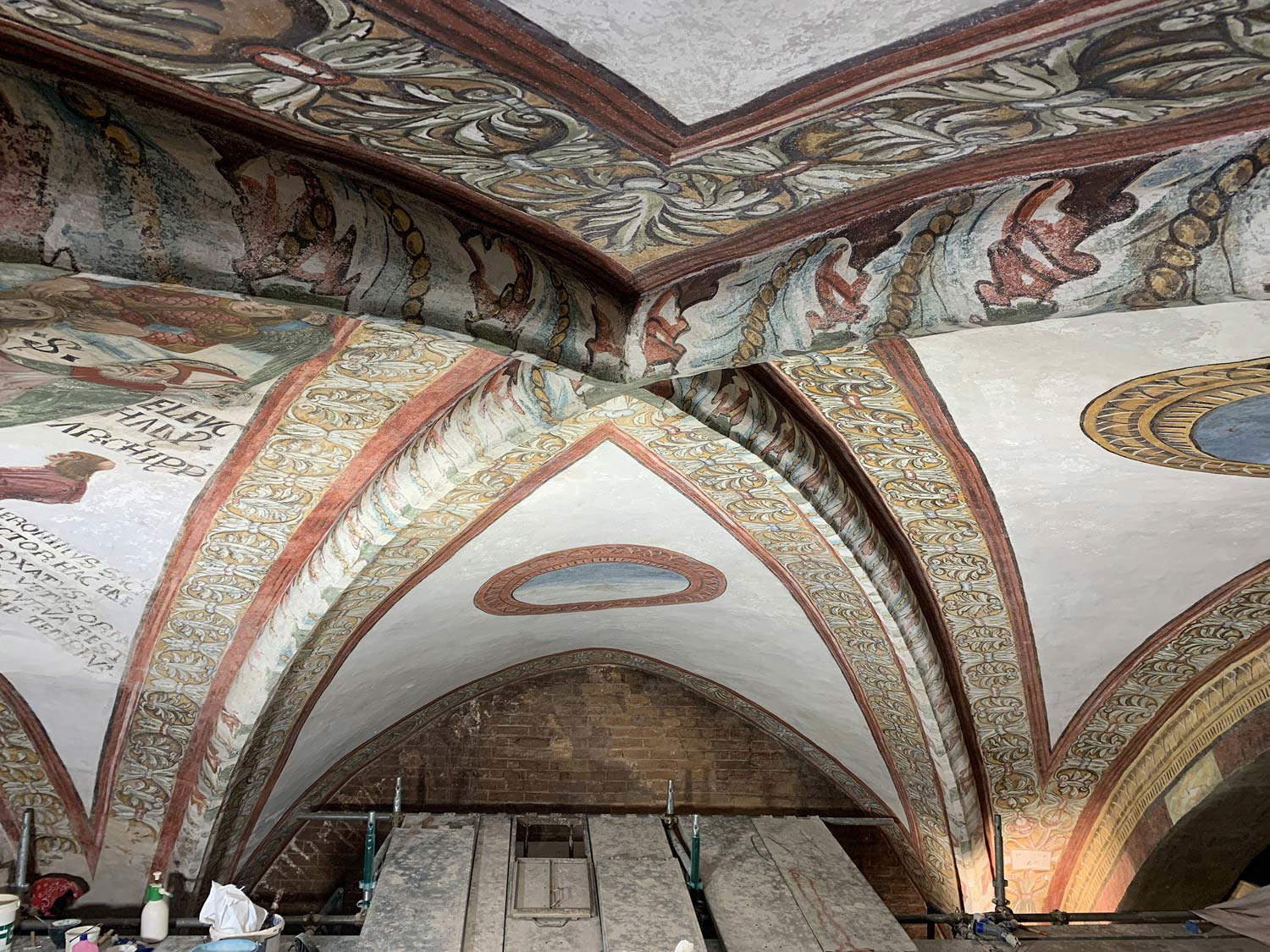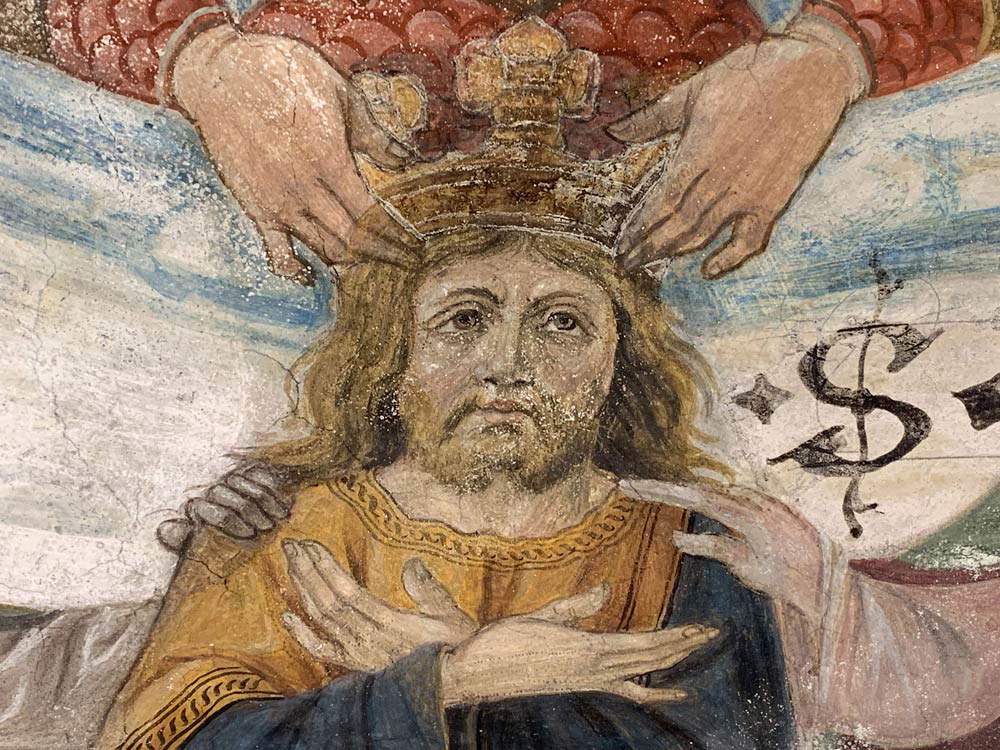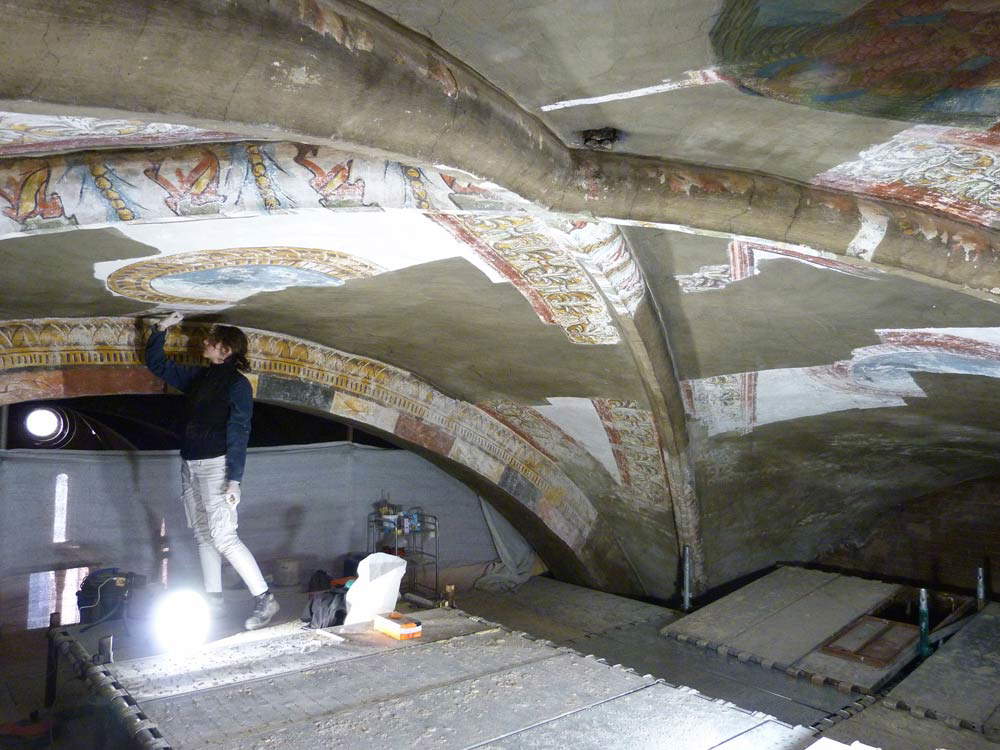In Pavia, in the basilica of San Michele Maggiore, one of the most important buildings of worship in northern Italy (it was also the site of coronations of kings of Italy in the ancient past), the precious frescoes in the cross vault of the nave have been visible again since June 22. The paintings, created between the late 15th and mid-16th centuries and covered over in the 19th century, are finding light thanks to the just-completed restoration, which is in addition to the already completed restoration of the cross vault of the presbytery and delivered last March 2022.
The public will have the opportunity to find a basilica of San Michele Maggiore completely changed in appearance, different from how it used to be admired until recently. Brightly colored frescoes have in fact re-emerged, which visitors will find as they raise their eyes to the vaults. The rediscovery of the frescoes was made possible by descialbatura work that freed them from the pictorial layers that covered them. Precisely the chromaticism of its paintings was a characteristic for which the basilica was famous in ancient times: the colors, moreover, appear with great evidence even on the capitals, also the objects of the restoration.
The novelty of this intervention consists in theactualization of the basilica’s appearance after the restoration carried out in 1865, which went back to a historicist theory that recognized in Romanesque-style architecture coloring in neutral tones, however dull. Among the most important discoveries is the discovery of a fresco depicting a man, initially identified as Frederick Barbarossa, crowned emperor in this very church, but thought (without, however, having exact certainty) to belong to Emperor Constantine, by virtue of a cartouche that appears next to his figure.
The works were directed and coordinated by architect Carlo Bergamaschi of the A7design design studio of Pavia, in collaboration with the scientific committee and supervision of the Soprintendenza Archeologia, Belle Arti e Paesaggio for the provinces of Como, Lecco, Monza-Brianza, Pavia, Sondrio and Varese, the scientific collaboration generated by the agreement with the three universities, as indicated in the annex and promoted by the Associazione Il Bel San Michele onlus of Pavia. The realization of these restorations, included in the project foreseen by the Integrated Plans for Culture - PIC, of the Lombardy Region, which has contributed in an important way together with the Luigi Rovati Foundation of Monza, ASM Pavia, the Community Foundation of the Province of Pavia, the Bracco Foundation of Milan, Coop Lombardia, Universitiamo of Pavia, and donations from private individuals. Work at San Michele will continue in the coming months and will insist on cleaning the vaults and opening to the public the inframural paths that run in the thickness of the facade walls and along the women’s galleries.
“The restoration and enhancement works,” says Vittorio Vaccari, president of the Associazione Il Bel San Michele onlus of the Basilica di San Michele in Pavia, “stem from the keen desire to be able to hand over to future generations a monument, bequeathed to us by our fathers and, at the same time, to ensure that today’s community has greater liturgical and cultural usability and knowledge of its history. This is why we have set ourselves the goal of reconfirming this architectural jewel as a religious and cultural landmark for the City, which is characterized by dozens of civil and religious testimonies of the Romanesque period.”
 The
The The frescoes
The frescoes The frescoes
The frescoes The frescoes
The frescoes The frescoes
The frescoes The
TheOf Lombard foundation, the church of St. Michael of Pavia was probably erected on the site of an earlier pagan building converted by Constantine into a Christian church. Later, possibly destroyed by invasions (such as that of the Hungarians in 924), fires (in 1004), destruction of the Palace (in 1024) and earthquakes (in 1017), it was rebuilt, probably, in the 12th century. It became the site of coronations of several Italic kings, such as Arduin of Ivrea (1002), Otto II (1004) and Frederick Barbarossa (1155). The importance of this basilica can be linked to the significant Romanesque-style building elements, with particular reference to the unique of the bas-reliefs on the façade that highlight the influence connected with a vast system of international relations, especially with the East, carried out by highly qualified people (from St. Enodius onward) and multiple experiences arising from a vast network of territorial migrations, with particular reference to the master builders who collected and exchanged experiences that they then deposited in their works, from which memories of dialogic forms and techniques from all over Europe transpire.
The particularity of St. Michael’s, built of sandstone, is that all other Romanesque emergencies in Pavia are, in that period, built of brick. It can also be pointed out that the reconstruction of the present Basilica of San Michele with the demolition of the previous Lombard church took place in a period of strong communal transformation in which the role of the bourgeoisie and the increasingly present role of the bishop were affirmed; at that time the imperial delegates were based in Lomello: it is emblematic that a church of this structural and stylistic importance was not a cathedral.
TheRomanesque experience in Lombardy found its important points of reference in Santa Maria in Lomello, San Michele in Pavia, Sant’Abbondio in Como, and Sant’Ambrogio in Milan, where, originally, the major pillars alternated with the minor ones in a composition in which the rectangular bay gathered the two arches of the women’s galleries and the upper clerestory into a single vault. This was a very heavy structure that discharged part of its mass on the major pillars and aisles, but it allowed openings that endowed the church with greater luminosity. In St. Michael’s, the nave was covered by only two vaults, which supported, directly, the roof of the basilica. At the ridge of each vault were double single-lancet windows on both sides: the weight of this structure compromised the static conditions of the nave so that a later intervention of complete reconstruction of the order of the new crosses took place at the end of the 15th century.
Between 1488 and 1491 Jacopo da Candia, master architect, was called to intervene with his son Agostino. The intervention carried out does not restore the two partially collapsed vaults but pulls them down and replaces them with four lighter vaults that have held up very well until today. The large sandstone cross vault is replaced by two smaller, lighter brick cross vaults. To this day, the only original cross vault is the presbytery vault. The pictorial heritage, the frescoes covering the vaults, can be dated between the late 15th and mid-16th centuries.
The intervention on the vaults has made it possible to initiate lines of research on both the pictorial apparatus, the construction systems of the vaults and roofs, and the characteristics of the brick masonry mantle, for specific knowledge of the construction systems and the methods of intervention carried out on the basilica.
 |
| Pavia, 15th century frescoes return to view at San Michele Maggiore after centuries |
Warning: the translation into English of the original Italian article was created using automatic tools. We undertake to review all articles, but we do not guarantee the total absence of inaccuracies in the translation due to the program. You can find the original by clicking on the ITA button. If you find any mistake,please contact us.